Schedule Monthly Publication date February – June 1986 Penciller(s) Frank Miller Writer Frank Miller | Number of issues 4 Publisher DC Comics | |
 | ||
Adaptations Similar The Dark Knight III: The Mast, Batman Family, 52, Justice, Batman/Superman/Wonder Woman: Trinity | ||
The dark knight returns comic breakdown
The Dark Knight Returns (alternatively titled Batman: The Dark Knight Returns) is a 1986 four-issue comic book miniseries starring Batman, written by Frank Miller, illustrated by Miller and Klaus Janson, and published by DC Comics. When the series was collected into a single volume later that year, the story title for the first issue was applied to the entire series. The Dark Knight Returns tells an alternative story of Bruce Wayne, who at 50 years old returns from retirement to fight crime and faces opposition from the Gotham City police force and the United States government. The story introduces Carrie Kelley as the new Robin and culminates with a confrontation against Superman.
Contents
- The dark knight returns comic breakdown
- The dark knight returns 1
- Plot
- Characters
- Background and creation
- Reception
- Influence
- Television
- Film
- Merchandise
- Comic books
- References

A three-issue sequel written and illustrated by Miller, The Dark Knight Strikes Again, was published in 2001. An eight-issue third installment, The Dark Knight III: The Master Race, co-written by Miller and Brian Azzarello, was published twice-monthly starting in late 2015. Frank Miller has said he is working on a fourth series. In addition, a 64-page prestige format one-shot co-written by Miller and Azzarello, Dark Knight Returns: The Last Crusade, which serves as a prequel to the original series, was released on June 15, 2016. Additionally, Spawn/Batman was released in 1994 as a companion to The Dark Knight Returns, and, according to Miller, the series All Star Batman & Robin, the Boy Wonder can be considered a prequel.
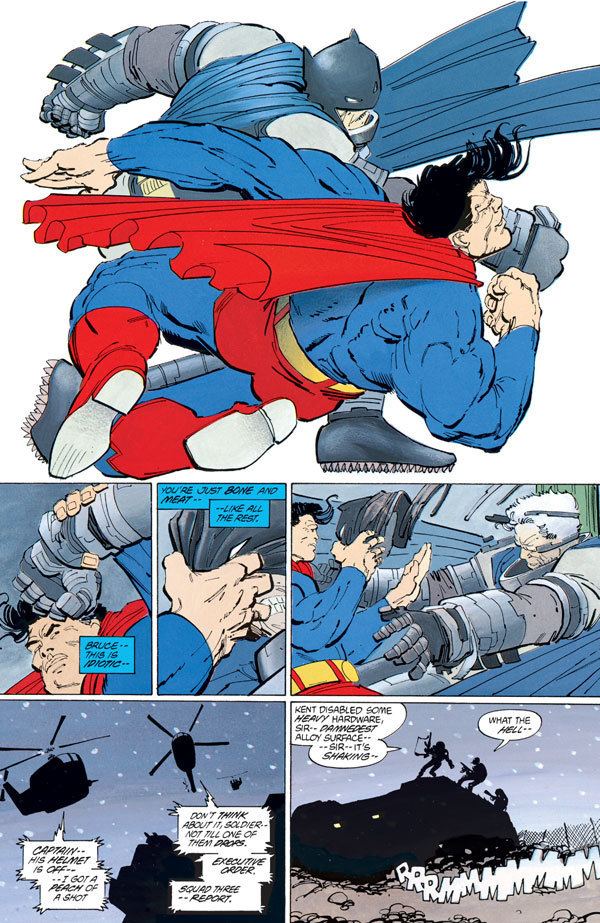
In the pre-Flashpoint DC Multiverse, the events of The Dark Knight Returns and its associated titles were designated to occur on Earth-31.
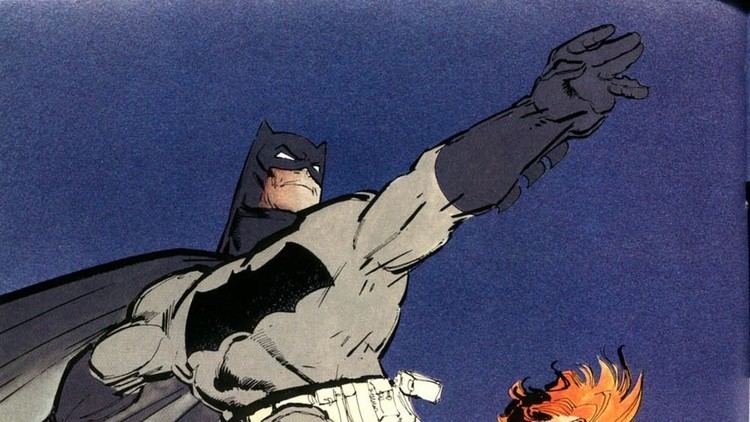
The dark knight returns 1
Plot
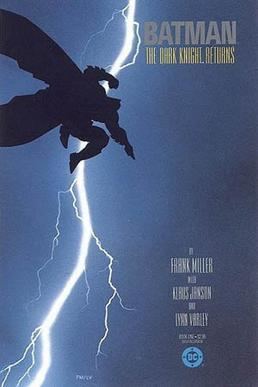
The Dark Knight Returns is set in a dystopian near-future version of Gotham City. Bruce Wayne, at 50, has given up the mantle of Batman after the death of Jason Todd 10 years prior. As a result, crime is running rampant through the city and a gang calling themselves 'The Mutants' has risen to terrorize the people of Gotham. Upon seeing this, Wayne returns to his role as a vigilante. On his first night as Batman he puts a stop to multiple assaults- including one on two young girls, Carrie Kelley and her friend Michelle. While attempting to foil an armed robbery on the same night, Batman learns that the men involved are working for Harvey Dent. Dent, previously known for his criminal acts as Two-Face, underwent extensive therapy and plastic surgery financed by Wayne to reemerge into society. Batman informs Commissioner James Gordon that Dent may be planning a larger scheme. Soon after, Dent hijacks the television sets of the city and announces his intention to hold the city to ransom with a bomb. When Batman defeats Dent and his goons, he realizes that Dent's mind has completely warped into his Two-Face persona.
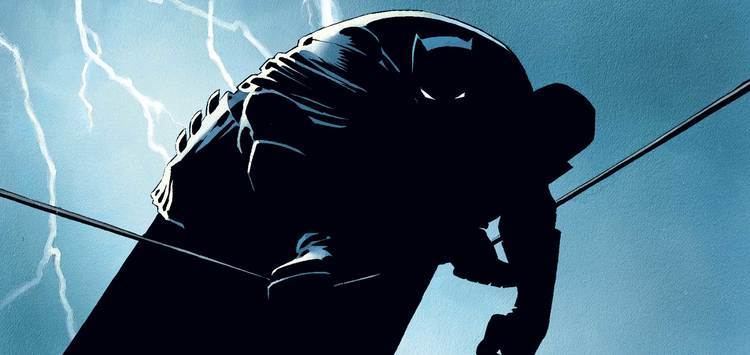
Inspired by Batman's rescue, Kelley buys herself an imitation Robin costume and searches for him, seeking to help him. She learns that Batman will be at the city dump and follows the Mutants there. Although Batman defeats the Mutants with his advanced weaponry in the ensuing battle, the Mutant Leader ends up goading him into a fight. During their hand-to-hand brawl, Batman, despite being able to match the Leader in strength, is rusty and slightly slow due to a decade's lack of activity which results him in getting seriously injured. Kelley creates a diversion, allowing Batman to immobilise the Mutant Leader, and the two of them escape. At the Batcave, Wayne's butler Alfred Pennyworth tends to his wounds while Kelley admires the Robin costume that belonged to Todd. Wayne decides to keep Kelley as his new sidekick. Gordon allows Batman to defeat the Mutant Leader (who he had arrested) on his own terms. The two engage in a fight at a sewage run-off pipe surrounded by members of the Mutant gang. Batman, leveraging the mud from the sewage to slow him down, deals the Leader a brutal defeat. Seeing Batman defeat their leader, the Mutants disband and some rename themselves the Sons of Batman, using excessive violence against criminals.
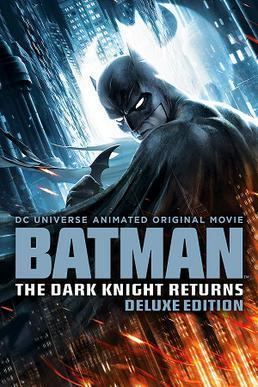
At the White House, Superman and the president discuss the events in Gotham, with the latter suggesting that Superman may have to arrest Batman. Superman informs the president that he may only be able to talk to Wayne. He is then deployed by Washington to the Latin American country of Corto Maltese where he fights Soviet combat forces in a conflict that may ignite WWIII.
Gordon hands over the role of commissioner to Captain Ellen Yindel, who issues a statement declaring that Batman is a wanted criminal for his vigilante activities. At the same time, Batman's return stimulates the Joker to awaken from catatonia at Arkham Asylum. With renewed purpose, the Joker manipulates his caretakers to allow him onto a television talk show, where he murders everyone with gas and escapes. Batman and Robin track him to a county fair while evading a police pursuit led by Yindel. There, they realise that he is already making attempts to kill fairgoers. Batman defeats the Joker in a violent confrontation, nearly killing him. To incriminate Batman for murder, the Joker seemingly commits suicide by breaking his own spine. After another confrontation with the Gotham police, Batman escapes with the help of Robin and a citywide manhunt begins.
Superman diverts a Soviet nuclear warhead which detonates in a desert, nearly killing himself in the process. The United States is hit by an electromagnetic pulse as a result and descends into chaos during the resulting blackout. In Gotham, Batman realizes what has happened, and he and Robin turn the remaining Mutants and Sons of the Batman into a non-lethal vigilante gang. He leads them against looters and ensures the flow of essential supplies. In the midst of the blackout, Gotham becomes the safest city in the country. The U.S. government sees this as an embarrassment, and orders Superman to remove Batman. Oliver Queen predicts to Wayne that the government lackey Superman and the maverick Batman will have a final confrontation. Superman demands to meet Batman. Knowing he may die, Wayne chooses Crime Alley, where he first became Batman. He relies on Superman's weakness caused by near-death in the nuclear blast (Superman only just managed to survive by absorbing the energy of the sun, but he is still vulnerable to attack).
Superman tries to reason with Batman, but Batman uses his technological inventions and mastery of hand-to-hand combat to fight him. During the battle, Superman compromises Batman's exoframe, while Queen shoots a kryptonite-tipped arrow to greatly weaken Superman. Batman reveals that he intentionally spared Superman's life by not using a more powerful kryptonite mix; the fight and near-death experience was meant as a warning to Superman to stay out of Batman's way. Before he can fully defeat Superman, Batman suddenly has a heart attack, apparently dying. Alfred destroys the Batcave and Wayne Manor before dying of a stroke, exposing Batman as Bruce Wayne, whose fortune has disappeared. After Wayne's funeral, it is revealed that his death was staged using his own chemical concoction that can suspend his vital life signs. Clark Kent attends the funeral and winks at Robin after hearing Wayne's heartbeat resume. Some time afterward, Bruce Wayne leads Robin, Queen, and the rest of his followers into the caverns beyond the Batcave and prepares to continue his war on crime.
Characters
Background and creation
In the early 1980s, DC Comics promoted Batman group editor Dick Giordano to editorial director for the company. Writer-artist Frank Miller was recruited to create The Dark Knight Returns. Giordano said he worked with Miller on the story's plot, and said, "[t]he version that was finally done was about his fourth or fifth draft. The basic storyline was the same but there were a lot of detours along the way." During the creation of the series, fellow comics writer/artist John Byrne told Miller, "Robin must be a girl", and Miller complied. Miller said that the comic series' plot was inspired by Dirty Harry, specifically the 1983 film Sudden Impact, in which Dirty Harry returns to crime-fighting after a lengthy convalescence. Miller also said his own increasing age was a factor in the plot. The series employed a 16-panel grid for its pages. Each page was composed of either a combination of either 16 panels, or anywhere between sixteen and one panel per page. Giordano left the project halfway through because of disagreements over production deadlines. Comics historian Les Daniels wrote that Miller's idea of ignoring deadlines was "the culmination of the quest towards artistic independence".
The issues of The Dark Knight Returns were presented in packaging that included extra pages, square binding and glossy paper to highlight the watercolor paintings by colorist Lynn Varley.
Reception
Despite the cost of the single-issue packaging, The Dark Knight Returns sold well. Priced at $2.95 an issue, DC Comics promoted The Dark Knight Returns as a "thought-provoking action story". Time said the series' depiction of a "semi-retired Batman [who] is unsure about his crime-fighting abilities" was an example of trying to appeal to "today's skeptical readers".
IGN Comics ranked The Dark Knight Returns first on a list of the 25 greatest Batman graphic novels and called The Dark Knight Returns "a true masterpiece of storytelling" with "[s]cene after unforgettable scene." In 2005, Time chose the collected edition as one of the 10 best English language graphic novels ever written. Forbidden Planet placed the collected issue at number one on its "50 Best of the Best Graphic Novels" list. Writer Matthew K. Manning in the "1980s" chapter of DC Comics Year By Year A Visual Chronicle (2010) called the series "arguably the best Batman story of all time." It was placed second in a poll among comic book academics conducted by the Sequart Organization.
The series also garnered some negative reviews. In April 2010, Nicolas Slayton from Comics Bulletin ranked The Dark Knight Returns second in his Tuesday Top Ten feature's Top 10 Overrated Comic Books behind Watchmen. Slayton wrote, "[t]here is no central plot to the comic, leaving only a forced fight scene between Superman and Batman as an out of place climax to the story." "Gone are the traits that define Batman," also citing "misuse of the central character." The New York Times gave the 1987 collected release of the series a negative review. Mordecai Richler felt that The Dark Knight Returns was not as imaginative as the work of Batman creator Bob Kane. Richler commented, "The stories are convoluted, difficult to follow and crammed with far too much text. The drawings offer a grotesquely muscle-bound Batman and Superman, not the lovable champions of old." He concluded, "If this book is meant for kids, I doubt that they will be pleased. If it is aimed at adults, they are not the sort I want to drink with."
Influence
The immense popularity of The Dark Knight Returns served both to return the character of Batman to a central role in pop culture, but also (along with Watchmen) started the era known as the Dark Age of Comic Books (also known as the Modern Age and the Iron Age). The grim, seedy versions of Gotham and Batman successfully updated the character's identity from the campy Adam West version remembered from the 1960s Batman TV series, and proved critically and commercially successful enough that a new wave of "dark" superheroes were either created, repopularized, or revamped altogether to fit this new trend.
The Dark Knight Returns was one of the two comic books, alongside Watchmen, that inspired designer Vincent Connare when he created the Comic Sans font.
Television
Film
Merchandise
In 1996, to commemorate the 10th anniversary of the graphic novel, DC released a new hardcover and a later softcover release. These included original rough script text for issue #4 with some sketches by Miller. There was also a limited edition slip cased hardcover that had mini poster prints, separate media review and sketch book by Miller. DC Direct released a limited edition statue of Batman and Robin designed by Miller. It was released in full size and then later as a mini sized statue. DC Direct released a series of Batman action figures based on The Dark Knight Returns in 2004. It included figures of Batman, Robin, Superman, and The Joker. Later, a Batman and Joker Gift Set was released, including both characters with new color schemes to reflect earlier points in the story, and a 48-page prestige format reprint of The Dark Knight Returns #1 was also released. An action figure of Batman as he appears in The Dark Knight Returns was released by Mattel in 2013, as part of their Batman Unlimited line of action figures.
